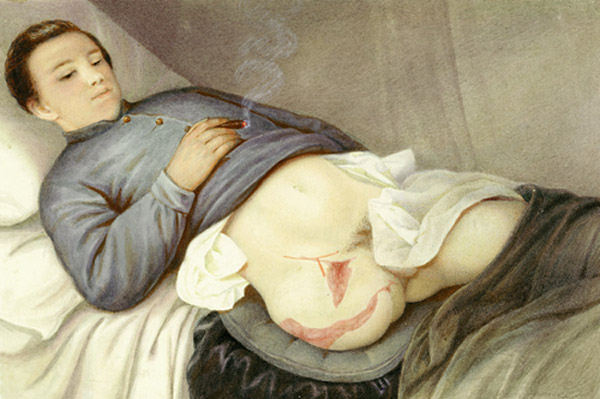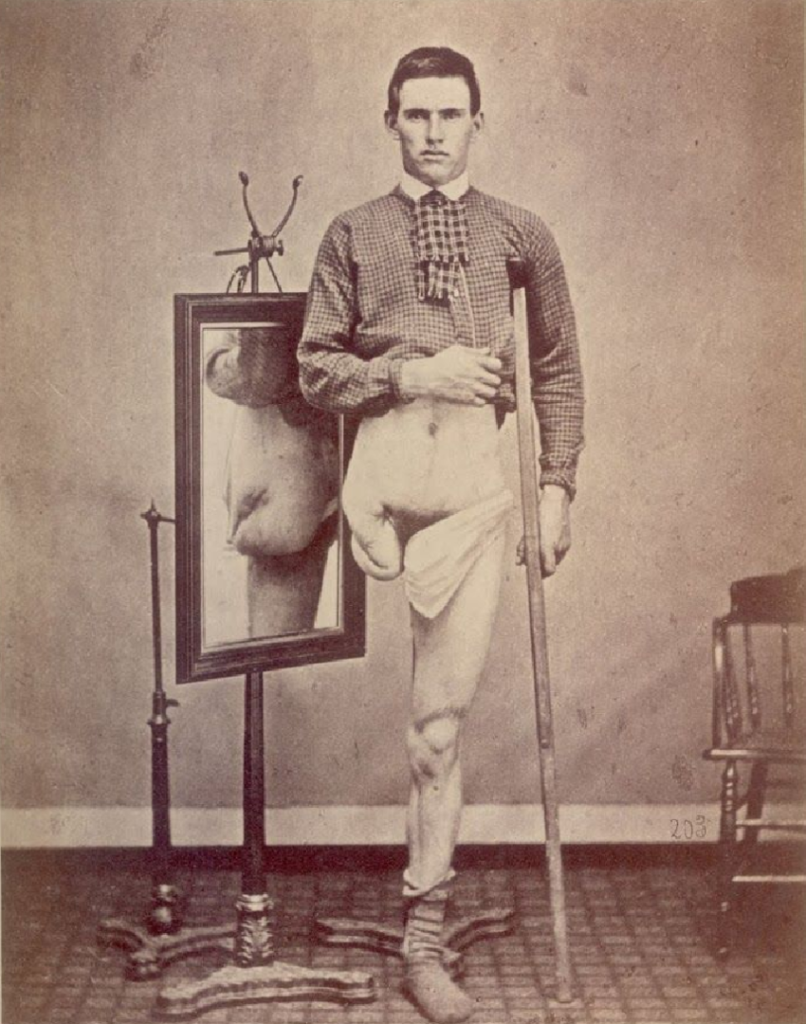Civil War Art: Eben E. Smith — Sequel of Amputation
This blog post contains graphic images and descriptions.
With or without consent, Civil War soldiers’ injuries and bodies became teaching tools for the field of medicine. Specimens were collected, preserved, labeled, and studied. Corpses were sent for autopsies. Surviving soldiers were photographed, identified, and those graphic images of their injuries appeared in medical reports and tomes. Working alongside the medical men and researchers were skilled artists, making intricate sketches or color illustrations of injuries, severed body parts, or the dead. These images can be difficult to look at and are extremely realistic – understandably since they were to teach the next generation of medical students and nurses. Most of these realistic images are clinical and sharp in their style.
Scrolling through archives of digitized Civil War art, this image stood out. First, it was shocking since it was in an online collection that did not have much medical teaching art. On closer examination, it is medical art, but it is also softer, humanized, and individualized in style. The young soldier reclines on his back, vulnerable and somewhat exposed. The viewer’s eye is immediately drawn to the healing amputation site: his entire right leg is gone, surgically severed near the hip. The young man’s eyes are downcast, almost with a resignation, but he holds a lighted cigar and there is an indomitable strength conveyed in the positioning of his upper body. He has a will to live. The young man’s injury is bared for the viewer to see, but the artist captured more than the effects of war on his body. The image tells a story of painful determination, too.

Peter Baumgras created this painting, probably in 1865. The painter had been born in Germany in 1827 and studied art at Dusseldorf Academy and the Munich Royal Academy before immigrating to the United States in 1853. Baumgras lived in Syracuse, New York, for a few years, then married Mary Thomson in 1856 and moved to Washington City. He successfully exhibited at the Washington Art Association in 1859 and was praised for his still-life paintings and portraits. When the Civil War began, he enlisted and became a “surgical draftsman” – drawing the results of battlefield projectiles and surgeon on human bodies. Eventually, Baumgras was asked to serve as the Assistant Professor of Drawing at the U.S. Naval Academy.[i] Probably at Beverly Hospital in New Jersey during the winter of 1865, Baumgras met Private Eben E. Smith from the 11th Maine Infantry Regiment – the young soldier in this painting.
Eben Smith hailed from Maine and was born on March 30, 1845. In 1862, Smith enlisted in the 26th Maine Infantry and fought in Louisiana, mustering out with the regiment in August 1863. In February 1864, he enlisted with the 11th Maine Infantry and fought through the Overland Campaign.
On August 16, 1864, Smith fought with his regiment at the battle of Second Deep Bottom. There, “a musket ball passed through the right leg from within outward, fracturing the head of the tibia. The wounded man was conveyed to a field hospital of the Tenth Corps, where it was determined that an attempt should be made to preserve the limb.”[ii] Cold cloths and possibly ice were applied to the wound, and Smith was transported north on a hospital steamer, arriving at a hospital in Beverly, New Jersey, on August 22. “On admission, he suffered but little pain, though the knee joint was considerably swollen.”[iii]
A few weeks later, on September 14, heavy bleeding prompted the attending surgeons to advise an amputation. The surgeons gave Smith chloroform, then performed the amputation at the “lower third of the thigh.”[iv] Doctors dissected the amputated limb and sent it to the Army Medical Museum for preservation and research. Thus far, Smith’s opinion or letters have not been located, leaving questions about how he felt about his circumstances and the research fate of his leg. Smith seemed to be recovering well, until October 17, when he lost an estimated 12 ounces of blood in sudden hemorrhaging from the stump. Surgeons reacted quickly, ligaturing part of the femoral artery. The amputation site “remained in an unhealthy condition with copious fetid suppuration, and the necrosed extremity of the femur protruced from the upper angle of the wound.”[v]
On November 5, Smith underwent another operation which exposed and then removed the infected femur bone. “After this the stump became much swollen, frequent abscesses formed, and it was finally decided that necrosis involved the [remaining] femur.”[vi] Simply stated, Smith’s remaining leg bone was dying while still attached to his body and causing continued infection.
Surgeons took Smith to the operating table again on January 19, 1865. They gave him chloroform to ease the pain and made an incision to explore the unhealed wound, and they found life-threatening infection. The surgeons then performed the third and final amputation on Smith’s limb, close to his hip. The chances of recovery from this type of operation were tragically low; hip amputations had a mortality rate of over 80% according to the reported cases in the Medical and Surgical History of the Civil War.[vii]
When Smith recovered consciousness from the operation, he was in a state of “extreme depression,” indicating medical shock and not necessarily a note on his state of mind. He “was kept on the amputating table for two or three days, lest an attempt at removal should prove fatal. Large quantities of stimulants and concentrated food were administered, and artificial warmth was applied to the surface of the body.”[viii] Smith continued to experience sudden hemorrhaging, losing six ounces of blood on January 27 and bleeding profusely again on February 17. For the last two weeks of February, “direct compression” was kept on his injury, possibly meaning that a nurse or attendant kept direct pressure on the healing blood vessels. “After this the patient rapidly improved, and by the end of March, he was quite well.”[ix]

Smith improved rapidly and by April 12, he transferred to White Hall Hospital in Bristol, Pennsylvania. He was discharged from military service on May 27, 1865, “with a sound stump and robust health.” Smith returned to Maine and received a soldier’s pension. By February 1867, he self-reported that “his general health was excellent, but that…his stump was painful.”[x] Surgeons confirmed his statement, and in July 1867, a doctor photographed Smith’s healed surgery results. Smith was not able to wear a prosthetic limb due to continued pain in his stump and the condition of the remaining bone. By 1874, a doctor certified that “the pensioner cannot sit to work at any trade or to write, and as he cannot wear an artificial limb, he can perform no labor in an erect position.”[xi] Four years later, the same conditions remained but Smith had no further disability to report.
Eben Smith lived until 1921, and when he died, the local paper printed a lengthy obituary that gives a glimpse of how this veteran chose to live his life with courage, purpose, kindness, and love. Here is the obituary in its entirety:
In the death of Eben E. Smith on Thursday, August 18, at the age of seventy-six years, the community loses an esteemed citizen and Civil War veteran. The whole town mourns.
Comrade Smith was born in Eastbrook, March 30, 1845, but had been identified with the town of Franklin nearly all his life. His patriotism led him, when a mere boy to be one of the first to enlist in the Civil War. Joining Co. C, 26th Maine regiment, his record was one of unflinching bravery and devotion to his country’s flag.
Taking part in the battles of the struggle to open the Mississippi, he was wounded at Port Hudson. At the expiration of his term of enlistment, he at once joined Co. G, 11th Maine, and was in the famous hammering campaign before Richmond. At Strawberry Plain he was so severely wounded that only his indomitable will brought him through. As a result of this wound, he was obliged to go through life handicapped by the loss of a leg.
Undaunted by what would have been considered an almost unbearable affliction by many, he took up nearly all the activities of his former life. After his discharge, he spent some years with his brothers in Wisconsin, but the call of home and early friendships drew him back to Franklin. Here he married Mrs. Rachael Dyer. They have lived a happy life, and their home has been one where all were welcome.
Kindly to everyone, Mr. Smith was an especial favorite with the children by whom he will be sorely missed. Always full of life and comradeship, he was a welcome guest at all gatherings, but especially to those of the G.A.R. and the D. of V., where his stories and hearty voice in song will be remembered by all.
At his funeral, held at the Baptist church Sunday, one of the largest gatherings in the history of the church assembled to do him honor. The services were conducted by Miss Margaret Koch and Rev. Gideon Mayo, former pastors of the church and personal friends of the deceased, interment was at Bay View cemetery.
Mr. Smith leaves, besides his wife, eight nephews, Fred Osgood, Fred and Harry Smith of Ellsworth; William, Frank and Walter Smith, of Massachusetts; Charles Follett, of Gouldsboro, and Fred Mitchell, of South Penobscot; and four nieces, Lucy Johnston of Bar Harbor, Annie Campbell of Ellsworth; Georgia Patch, of Boston, and Julia Morey, of Wisconsin.
There has gone from among us a patriotic citizen, a loving husband, a friend to all and one whose memory will last through long years to come.[xii]
The image that artist Peter Baumgras created of a young man lying in a hospital bed after a third and final amputation is not where Eben Smith’s story ended. He had been through a type of medical hell with pain, uncertainty, repeated operations, and episodes of gushing blood when he might have thought he was going to die. But he survived it all.
Baumgras’s painting is entitled “Sequel of Amputation,” and he showed the physical sequel with hints at the patient’s fortitude and determination in the reclined posture, expression, and loosely held cigar. Smith lived and wrote his own sequel to amputation – a life that was difficult but that he chose to fill with kindness and purpose that was admired, honored, and remembered.
Works Consulted:
Surgeon General’s Office, Reports on the extent and nature of the materials available for the preparation of a medicals available for the preparation of a medical and surgical history of the rebellion, (1866). Page 49. Accessed through Google Books.
“Eben E. Smith” – wuvcw.org/past-photos-ebenesmith
The Story of One Regiment: The Eleventh Maine Infantry Volunteers in the War of the Rebellion (New York: Press of J. J. Little & Co, 1896). Accessed through archive.org
“Report of Interesting Surgical Operations, Performed at the U.S.A. General Hospital, Beverly, New Jersey.” Accessed through Collections.NLM.NIH.GOV
Sources:
[i] “Peter Baumgras”, www.questroyalfineart.com
[ii] Medical and Surgical History of the War of the Rebellion, Volume 2, Part 3 (1883), Page 155.
[iii] Ibid.
[iv] Ibid.
[v] Ibid.
[vi] Ibid.
[vii] Ibid., Page 127.
[viii] Ibid., Page 155.
[ix] Ibid.
[x] Ibid.
[xi] Ibid.
[xii] Ellsworth American, August 24, 1921, Page 4. Accessed through Newspapers.com
2 Responses to Civil War Art: Eben E. Smith — Sequel of Amputation